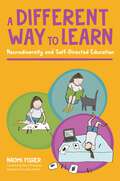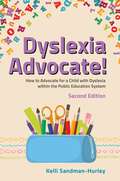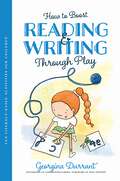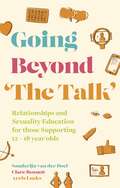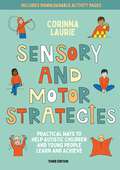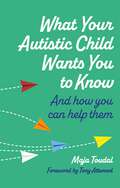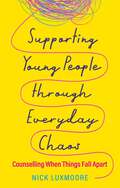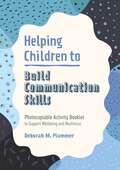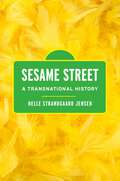- Table View
- List View
A Different Way to Learn: Neurodiversity and Self-Directed Education
by Naomi Fisher'If you are a parent worrying whether self-directed education will work for your child, because you have been told that they have special needs which can only be met in the school system - think again'Neurodivergent children experience and interact with the world differently to many of their peers. Standard educational systems often fail to adapt to their unique strengths and ways of learning. School, and even the act of learning, can become a source of great anxiety and trauma. Self-directed education offers an alternative to traditional schools that can help neurodivergent children develop at their own pace and thrive.Blending theory, practical advice and lived experience, clinical psychologist Naomi Fisher introduces the world of self-directed learning and tailoring the learning environment to your child.This comprehensive overview of self-directed learning is packed with ideas on how to implement it at home and includes interviews from parents of neurodivergent children on how you can make learning differently work for you and your child
Dyslexia Advocate! Second Edition: How to Advocate for a Child with Dyslexia within the Public Education System
by Kelli Sandman-HurleyThis updated edition of this bestselling, straightforward guide provides the essential information for parents and advocates to understand US law and get the right educational entitlements for a dyslexic child.Using case studies and examples, this book demonstrates clearly how to apply the Individuals with Disabilities Education Act (IDEA) to the unique requirements of a dyslexic child. It offers simple, intelligible help for parents on how to coordinate successfully with their child's school and achieve the right services and support for their dyslexic child; up to and beyond getting an effective Individual Education Plan (IEP).Dyslexia Advocate! is an invaluable tool for parents trying to negotiate a complex legal system to get the best outcome for their child. With brand new chapters on the structure of special education services in the US and current state laws, this guide is fundamental to understanding and advocating for your dyslexic child.
The Educator’s Experience of Pathological Demand Avoidance: An Illustrated Guide to Pathological Demand Avoidance and Learning
by Laura KerbeyI realised EVERYTHING I was doing was wrong.I needed to learn.I needed to change.During Laura Kerbey's time teaching autistic children, she had a sudden realisation that those with Pathological Demand Avoidance (PDA) are children like no other! None of her tried and tested autism strategies would work to help them focus or learn and most of her time was spent wondering, what am I doing wrong?If you feel the same, this short, easy-to-read guide is here to teach you everything you need to know from one educator to another. With an introduction to what PDA is followed by PDA tailored advice on how to connect with your student and create an autonomous, spontaneous environment that is personalised for you both, this guide is here to ensure that you and your PDA student thrive!Illustrated by the popular Eliza Fricker and packed with entertaining anecdotes (including one about Jabba the Hut's poo), this go-to-guide contains everything you need to start implementing PDA friendly learning to help you connect with your student and help them make the most of their learning experience.
More Than Words: Promoting Race Equality and Tackling Racism in Schools
by Sarah Soyei Kate HollinsheadYoung people develop their value systems during their school years, offering the perfect window of opportunity for educators to challenge prejudice and promote race equality during these formative years. Yet, as teacher training is increasingly school-centred and school budgets are stretched more thinly than ever, most teachers do not feel they have the time to develop the language or skills to do so.More Than Words is an easily implementable tool for all educators - teachers, senior leaders, governors and support staff - to help them look beyond fire-fighting racist incidents to create long-term systemic changes. Supporting teachers in a non-judgemental fashion, this book dismantles any myths they may be harbouring so they can engage with issues with an open mind, allowing them to create positive change. This comprehensive guide helps school staff to create a safe, inclusive and supportive environment for all young people.
How to Boost Reading and Writing Through Play: Fun Literacy-Based Activities for Children
by Georgina DurrantEven if children know their phonics and ABC's inside out and can read every book in their book bag, why is it still so difficult to get them to want to read and write? How do we begin to get our children excited about literacy? The answer might surprise you...let them play!Featuring 40 engaging play-based activities, this book makes literacy so fun that children won't notice they're also actively developing reading and writing skills. From blow painting words to making paper chain sentences, each activity can be done using household items and they are adaptable for children of any age and ability, making learning accessible for all. With charming black and white line illustrations to depict each activity, this is a great way to connect with children while helping to build their literacy skills at the same time.
Dyslexia and Me: How to Survive and Thrive if You’re Neurodivergent
by Onyinye UdokporoThroughout my life I have been told directly and indirectly that dyslexia is found in particular people... [In fact] dyslexia can be found in someone like me. It isn't just 'okay' but something to be proud of. This book has been written because I want people to know that dyslexia can be found in people of every colour, creed, or circumstance.In this book, rising star entrepreneur Onyinye Udokporo shares her story of growing up dyslexic in a society where neurodivergence was always presented as a white male issue.Onyinye discusses her experience of being diagnosed at 11 years old, starting a business the following year, gaining a scholarship to a prestigious boarding school and going on to complete two degrees by the age of 22, while also being honest about the difficulties she faced throughout including with bullying and anxiety. She shares the tips she picked up over the years for thriving with dyslexia and the strategies she used to overcome her difficulties in reading and writing well, staying organised and speaking with confidence.Illuminating wider issues of systemic racism in the educational sector and providing a timely reminder that dyslexia can be found in any community and culture, this is an empowering story of surviving and thriving in the face of adversity.
Building Better Therapeutic Relationships with Children: A Creative Activity Workbook
by Deborah SchroderBuilding therapeutic relationships with children is one of the largest challenges faced by therapists and counselors. This simple workbook provides easy-to-implement creative ideas and activities to strengthen therapeutic relationships and address common challenges. This book is an essential companion for therapists working with children/families.
Supporting the Development of Speech, Language and Communication in the Early Years: Includes Downloadable Assessment Tools, Checklists, Recording Forms, Advice and Information Leaflets and Intervention Strategies
by Jo Williams Diana McQueenSpeech and language impairment can have a huge impact on cognitive development. Identifying what is going wrong - and what effective intervention looks like - can be daunting. Short of retraining you as a speech and language therapist, this thorough guide will give you everything you need to change that.An essential resource, the book contains a wide variety of online resources, including phonological and sound awareness documents, assessment tools, and recording forms that can be downloaded straight to your device, providing excellent materials and activities to use in the classroom.Written by speech and language therapists and designed exclusively for Early Years practitioners, this book provides a complete overview of how children acquire language and what language impairments look like at this age. You will find both strategic and practical advice on how to manage and encourage the development of speech and language skills. Creating the optimum communication environment for every child in your setting is an important part of what the book offers. Equally, practitioners are supported to be able to recognise the features of specific language difficulties such as Developmental Language Disorder (DLD) and feel confident to intervene when children are struggling.
Going Beyond 'The Talk': Relationships and Sexuality Education for those Supporting 12 -18 year olds
by Clare Bennett Sanderijn van der Doef Arris LueksWith helpful and accessible advice, this is an informative guide to open communication with adolescents about relationships and sexuality. Highlighting the value of positive sexuality education and going beyond a single 'talk', it covers potential challenges and how to address them, offering developmentally appropriate guidance for 12-18-year olds.
Sensory and Motor Strategies (3rd edition): Practical Ways to Help Autistic Children and Young People Learn and Achieve
by Corinna LaurieIn this fully revised third edition, Corinna Laurie sets out practical strategies to help autistic children develop their sensory and motor skills. Learn to identify possible challenges, recognise signs of overload and work in a co-productive way with your student or child, developing sensory regulation strategies and improving motor skills to aid well-being.The simple, low-cost activities provide practical solutions to help children meet the demands of any situation, building skills from handwriting and using scissors to improving posture, co-ordination and motor planning. Sensory strategies include calming techniques and simple environmental modifications to prevent overwhelm, among many others.Helping to improve functional abilities and enable children to thrive and build independence, this is an essential resource for anyone working with children on the autism spectrum.
What Your Autistic Child Wants You to Know: And How You Can Help Them
by Maja Toudal"There are so many things I wish I could have told my parents when I was a child, but back then I did not have the words."It can be challenging understanding what your autistic child wants and needs, at times it can feel like a struggle to ask the right questions and find the right words.Written by autistic psychologist and advocate, Maja Toudal, in collaboration with other autistic voices, this candid book explores a range of common situational and social challenges an autistic young person may face and gives lived-experience advice on how to resolve them. Maja offers insights on everything from making mealtimes work for your child, to handling bullying and peer pressure, both at school and on social media, providing an insider's guide into the child's emotional life.With relatable and engaging advice on what your child needs and why, alongside chapters focusing on how to approach puberty, providing coping mechanisms for meltdowns, and offering insight into making safe spaces, this is the essential guide to parenting autistic young people.
Supporting Young People through Everyday Chaos: Counselling When Things Fall Apart
by Nick LuxmooreThis book provides ways to support and counsel young people struggling to adapt and live with the constant possibility of things breaking down, of normal life being overtaken by chaos. Covering many different types of 'everyday chaos' including anxiety, bullying, mental health, trauma, anger and loss, this book is an incredibly useful guide for anyone working with young people at a time when these issues are more prevalent than ever. It was inspired by the author's daughter's accidental death aged 27. Written in a warm and down-to-earth tone, the chapters use a variety of case studies to lead through examples on a range of problems young people are facing.
Helping Children to Build Communication Skills: Photocopiable Activity Booklet to Support Wellbeing and Resilience (Helping Children to Build Wellbeing and Resilience)
by Deborah PlummerLearning how to communicate effectively and healthily is an important skill for every child to learn. This practical and fun activity booklet facilitates parents, teachers, and therapists to build children's communication skills. It explores how and why we communicate, effective listening, non-verbal communication, and how to stay on topic. Using over thirty years of experience, Deborah Plummer helps children understand that their interactions reflect their beliefs about themselves and others, and shows how to recognise and celebrate the unique and diverse ways in which we express who we are.This book is one of a series based on the use of imagination (I), mindful play (MP) and creative thinking (CT) to enhance social, psychological and emotional wellbeing and resilience in children. The accompanying ebook Using Imagination, Mindful Play and Creative Thinking to Support Wellbeing and Resilience in Children describes the theory and approach behind how these activities can significantly influence children's perceptions of themselves and the world.
Dandelion Readers Extended Code Level 4 Book 12: (pdf)
by Story by Tamar Reis-Frankfort and Wendy Tweedie Illustrated by Clair Baker and Drew WilsonThe Extended Phonic Code series introduces the various spellings for each sound. It can be used with any phonic programme a school is teaching. The phonic progression in the series can be found on the back of this book.
Dandelion Readers Extended Code Level 4 Book 11: (pdf)
by Story by Tamar Reis-Frankfort and Wendy Tweedie Illustrated by Clair Baker and Drew WilsonThe Extended Phonic Code series introduces the various spellings for each sound. It can be used with any phonic programme a school is teaching. The phonic progression in the series can be found on the back of this book.
Dandelion Readers Extended Code Level 4 Book 8: (pdf)
by Story by Tamar Reis-Frankfort and Wendy Tweedie Illustrated by Clair Baker and Drew WilsonThe Extended Phonic Code series introduces the various spellings for each sound. It can be used with any phonic programme a school is teaching. The phonic progression in the series can be found on the back of this book.
Dandelion Readers Extended Code Level 4 Book 14: (pdf)
by Dandelion Readers Extended Code Level 4The Extended Phonic Code series introduces the various spellings for each sound. It can be used with any phonic programme a school is teaching. The phonic progression in the series can be found on the back of this book.
Dandelion Readers Extended Code Level 4 Book 3: (pdf)
by Story by Tamar Reis-Frankfort and Wendy Tweedie Illustrated by Clair Baker and Drew WilsonThe Extended Phonic Code series introduces the various spellings for each sound. It can be used with any phonic programme a school is teaching. The phonic progression in the series can be found on the back of this book.
Sesame Street: A Transnational History
by Helle Strandgaard JensenIn Sesame Street: A Transnational History, author Helle Strandgaard Jensen tells the story of how the American television show became a global brand. Jensen argues that because the show's domestic production was not financially viable from the beginning, Sesame Street became a commodity that its producers assertively marketed all over the world. Sesame Street: A Transnational History combines archival research from seven countries, bolstering an insightful analysis of how local reception and rejection of the show related to the global sales strategies and American ideals it was built upon. Contrary to the producers' oft-publicized claims of Sesame Street's universality, the show was heavily shaped by a fixed set of assumptions about childhood, education, and commercial entertainment. This made sales difficult as Sesame Street met both skepticism and direct hostility from foreign television producers who did not share these ideals. Drawing on insights from new histories about childhood, education, and transnational media, the book lays bare a cultural clash of international proportions rooted in divergent approaches to children's television. In doing so, it provides a reflective backdrop to the many ongoing debates about children's media. In contrasting the positive receptions and renunciations of Sesame Street, Jensen demonstrates that it was only after a substantial rethinking of Sesame Street's aims and business model that this program ended up on numerous broadcasting schedules by the mid-1970s. Along the way, this rethinking and the constant negotiations with potential international buyers created and shaped the business and corporate brand that paved the way for the Sesame Street we know today.
The Technique of Orchestration Workbook
by Kent Kennan Donald GranthamThe Technique of Orchestration Workbook, Seventh Edition, accompanies the textbook of the same name—the definitive resource on the study of orchestration—providing musical excerpts, full scores, and scoring assignments to enrich the lessons learned in the textbook. Spanning an array of periods and styles, the musical examples collected here cover scoring techniques in the following sections: Strings Woodwinds Brass Scoring of Chords Transcribing Piano Music Scoring for Woodwinds, Horns, and Strings Percussion Harp and Keyboard Instruments Scoring for Full Orchestra Additional learning tools include transposition exercises, error detection drills, and discussions on harmonics, while the workbook pages are perforated throughout for ease of use in and out of the classroom. Featuring the music of Bach, Mozart, Brahms, Beethoven, Schumann, Copland, Bartók, and many more, The Technique of Orchestration Workbook, Seventh Edition, is an invaluable companion to the textbook.
The Technique of Orchestration Workbook
by Kent Kennan Donald GranthamThe Technique of Orchestration Workbook, Seventh Edition, accompanies the textbook of the same name—the definitive resource on the study of orchestration—providing musical excerpts, full scores, and scoring assignments to enrich the lessons learned in the textbook. Spanning an array of periods and styles, the musical examples collected here cover scoring techniques in the following sections: Strings Woodwinds Brass Scoring of Chords Transcribing Piano Music Scoring for Woodwinds, Horns, and Strings Percussion Harp and Keyboard Instruments Scoring for Full Orchestra Additional learning tools include transposition exercises, error detection drills, and discussions on harmonics, while the workbook pages are perforated throughout for ease of use in and out of the classroom. Featuring the music of Bach, Mozart, Brahms, Beethoven, Schumann, Copland, Bartók, and many more, The Technique of Orchestration Workbook, Seventh Edition, is an invaluable companion to the textbook.
The Technique of Orchestration: Pearson New International Edition
by Kent Kennan Donald GranthamThe Technique of Orchestration, Seventh Edition, is the definitive textbook on the study of orchestration, offering a concise, straight-to-the-point approach that prepares students to score their own compositions with confidence. Updated to reflect developments in instruments and orchestral best practices, this seventh edition features: Copious musical examples spanning the history of the orchestra Detailed descriptions of instruments and their distinctive characteristics Explanations of how to score chords and transcribe piano idioms Discussions on specialized ensembles and scoring techniques New musical examples have been added throughout and listening lists have been revised to include more music by women and composers of color, representing a diverse musical catalogue. Supported by an accompanying workbook of scores and scoring exercises (available separately), as well as a robust listening program keyed to the textbook, The Technique of Orchestration, Seventh Edition, is an accessible, essential, all-in-one resource for the student of orchestration.
The Technique of Orchestration
by Kent Kennan Donald GranthamThe Technique of Orchestration, Seventh Edition, is the definitive textbook on the study of orchestration, offering a concise, straight-to-the-point approach that prepares students to score their own compositions with confidence. Updated to reflect developments in instruments and orchestral best practices, this seventh edition features: Copious musical examples spanning the history of the orchestra Detailed descriptions of instruments and their distinctive characteristics Explanations of how to score chords and transcribe piano idioms Discussions on specialized ensembles and scoring techniques New musical examples have been added throughout and listening lists have been revised to include more music by women and composers of color, representing a diverse musical catalogue. Supported by an accompanying workbook of scores and scoring exercises (available separately), as well as a robust listening program keyed to the textbook, The Technique of Orchestration, Seventh Edition, is an accessible, essential, all-in-one resource for the student of orchestration.
Embracing Ethnography: Doing Contextualised Construction Research
This book calls for those interested in robust construction research to embrace ethnography – in all its forms, including rapid ethnographies, ethnographic-action research, autoethnography, as well as longer-term ethnographies.The diversification of ethnographic approaches, as well as ethnographers, will lead to rich insights that can advance the industry theoretically and practically. We share experiences, key considerations and recommendations from leading construction ethnographic researchers from around the world to provide discussion, reflection and understanding into doing ethnography in the construction industry.This book is aimed at academics, students, consultants, editors, reviewers, policymakers, funders and others interested in robust research in the construction industry and built environment but will also be useful for those undertaking research within organisations in other industries.
Embracing Ethnography: Doing Contextualised Construction Research
by David Oswald Léon Olde ScholtenhuisThis book calls for those interested in robust construction research to embrace ethnography – in all its forms, including rapid ethnographies, ethnographic-action research, autoethnography, as well as longer-term ethnographies.The diversification of ethnographic approaches, as well as ethnographers, will lead to rich insights that can advance the industry theoretically and practically. We share experiences, key considerations and recommendations from leading construction ethnographic researchers from around the world to provide discussion, reflection and understanding into doing ethnography in the construction industry.This book is aimed at academics, students, consultants, editors, reviewers, policymakers, funders and others interested in robust research in the construction industry and built environment but will also be useful for those undertaking research within organisations in other industries.
